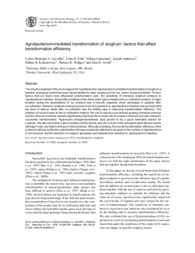Agrobacterium-mediated transformation of sorghum: factors that affect transformation efficiency.
Agrobacterium-mediated transformation of sorghum: factors that affect transformation efficiency.
Autoria: CARVALHO, C. H. S.; ZEHR, U. B.; GUNARATNA, N.; ANDERSON, J.; KONONOWICZ, H. H.; HODGES, T. K.; AXTELL, J. D.
Resumo: The results presented in this work support the hypothesis that Agrobacterium-mediated transformation of sorghum is feasible, analogous to what has been demonstrated for other cereals such as rice, maize, barley and wheat. The four factors that we found most influenced transformation were: the sensitivity of immature sorghum embryos to Agrobacterium infection, the growth conditions of the donor plant, type of explant and co-cultivation medium. A major problem during the development of our protocol was a necrotic response which developed in explants after co-cultivation. Immature sorghum embryos proved to be very sensitive to Agrobacterium infection and we found that the level of embryo death after co-cultivation was the limiting step in improving transformation efficiency. The addition of coconut water to the co-cultivation medium, the use of vigorous and actively growing immature embryos and the removal of excess bacteria significantly improved the survival rate of sorghum embryos and was critical for successful transformation. Hygromycin phosphotransferase (hpt) proved to be a good selectable marker for sorghum. We also found that β-glucuronidase (GUS) activity was low in most of the transgenic plant tissues tested, although it was very high in immature inflorescences. Although promising, the overall transformation efficiency of the protocol is still low and further optimization will require particular attention to be given to the number of Agrobacterium in the inoculum and the selection of sorghum genotypes and explants less sensitive to Agrobacterium infection.
Ano de publicação: 2004
Tipo de publicação: Artigo de periódico
Unidade: Embrapa Milho e Sorgo
Palavras-chave: Sorgo
Observações
1 - Por padrão são exibidas publicações dos últimos 20 anos. Para encontrar publicações mais antigas, configure o filtro ano de publicação, colocando o ano a partir do qual você deseja encontrar publicações. O filtro está na coluna da esquerda na busca acima.
2 - Para ler algumas publicações da Embrapa (apenas as que estão em formato ePub), é necessário ter, no celular ou computador, um desses softwares gratuitos. Sistemas Android: Google Play Livros; IOS: iBooks; Windows e Linux: software Calibre.
Acesse outras publicações
Acesse a Base de Dados da Pesquisa Agropecuária (BDPA) para consultar o acervo completo das bibliotecas da Embrapa.

